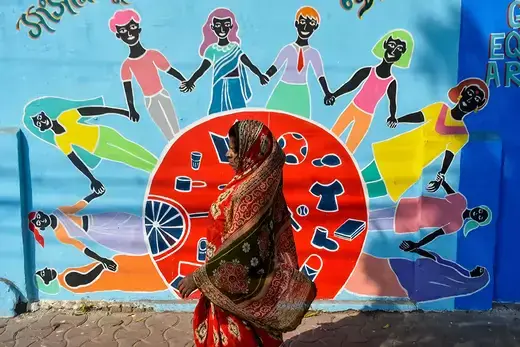UN Members See Need for Ramped-Up Progress on Gender Equality
UN Members See Need for Ramped-Up Progress on Gender Equality Council on Foreign Relations


Assessment of Progress on Gender Equality and the Sustainable Development Goals (SDGs)
This report provides an assessment of the progress made towards achieving gender equality, which is a key component of the Sustainable Development Goals (SDGs). The United Nations (UN) has identified gender equality as the single biggest driver for meeting all of the SDGs. However, halfway to the 2030 deadline, experts from the UN have identified various barriers that have impeded progress towards gender equality. These barriers include legal and institutional obstacles, deep-rooted bias, unequal political representation, economic disparities, and lack of legal protection and investment. To stay on track, it is crucial to make new commitments and take vigorous action.
United Nations’ Assessment of Progress on Gender Equality

An assessment conducted by UN Women and other UN agencies reveals that none of the fourteen indicators established for measuring gender equality have been met so far. Only two indicators are close to being achieved, while the remaining twelve are moderately to very far from reaching the 2030 target. These indicators cover areas such as laws against discrimination, intimate-partner violence, child marriage and female genital mutilation, unpaid care and domestic work, political representation, managerial positions, healthcare and reproductive rights, education, land rights, phone ownership, and government funding and data collection on gender equality.
Status of Women and Girls Across the SDGs
- SDG 1: Despite a decline in extreme poverty rates, it is projected that 340 million women and girls will still live in extreme poverty by 2030.
- SDG 2: One-quarter of women and girls will experience moderate to severe food insecurity by 2030.
- SDG 3: Currently, an estimated 129 million girls are out of school, and this number is expected to reach 110 million by 2030.
- SDG 4, 6, 7: Women and girls continue to face inadequate access to healthcare, water, and housing. Progress in reducing maternal mortality has also stalled since 2015.
- SDG 8: Women have lower labor participation rates and earn less than men.
- SDG 10: Discriminatory laws against women still exist in 54% of countries, and women are twice as likely as men to experience discrimination.
- SDG 12–15: Women are disproportionately affected by the impacts of climate change.
- SDG 16: The number of women living in conflict zones has increased by 50% since 2017.
- SDG 17: Only 4% of bilateral assistance is dedicated to reducing gender equality as a principal objective.
Actions to Accelerate Progress
In response to the assessment, member states have agreed to take several steps to accelerate progress. This includes a featured initiative on gender equality that calls for a $1 billion investment. The initiative focuses on eliminating violence against women and girls, which is seen as a major obstacle to improving their status. The economic impact of such violence is estimated at $1.5 trillion annually. The initiative aims to scale up efforts by governments and civil society organizations to remove discriminatory laws, provide services for abused women, pursue legal justice, improve access to healthcare and economic opportunities, increase women’s participation in leadership and decision-making, educate men and boys on positive masculinity, and raise public awareness about the need for gender equality. However, the call for $1 billion falls short of the UN’s estimated requirement of $360 billion per year to address gender equality comprehensively.
Other commitments made at the summit to accelerate progress across all SDGs can also contribute to advancing gender equality. For example, the digital public infrastructure initiative aims to provide internet access to 2.7 billion people and address online threats that disproportionately affect women and girls, such as gender-based harassment and cyberstalking. This initiative calls for the creation and adoption of a universal safeguard framework to ensure that the digital space protects human rights, including gender-responsive provisions. Additionally, the UN declaration approved by attendees calls for a $500 billion increase in annual commitments from member governments to ramp up progress on lagging SDGs. Restructuring international finance to support low- and middle-income countries is another priority for many UN member states seeking to mobilize the necessary investment for development, which would also benefit women and girls.
Importance of Gender Equality for Achieving the SDGs
The UN assessment emphasizes that “failure to prioritize SDG 5 will put the entire 2030 Agenda for Sustainable Development in peril.” As women and girls make up half of the world’s population, neglecting their needs will hinder overall well-being. Advancing the status of women and girls will have broader benefits for society. For instance, addressing the gender gap in food insecurity is estimated to add $1 trillion to global GDP. Improving their health, welfare, education, safety, legal rights, and political participation and leadership will enable women and girls to make significant contributions that advance global peace, stability, and security. Therefore, gender equality is the most critical driver for achieving all the SDGs.
SDGs, Targets, and Indicators Relevant to the Article
SDGs Addressed or Connected to the Issues Highlighted in the Article:
- SDG 5: Achieve gender equality and empower all women and girls
- Other SDGs indirectly connected to gender equality: SDG 1, SDG 2, SDG 3, SDG 4, SDG 6, SDG 7, SDG 8, SDG 10, SDG 12-15, SDG 16, SDG 17
Specific Targets under the SDGs Based on the Article’s Content:
- SDG 5.1: End all forms of discrimination against all women and girls everywhere
- SDG 5.2: Eliminate all forms of violence against all women and girls in the public and private spheres
- SDG 5.3: Eliminate all harmful practices, such as child marriage, female genital mutilation, and forced labor
- SDG 5.4: Recognize and value unpaid care and domestic work through the provision of public services, infrastructure, and social protection policies
- SDG 5.5: Ensure women’s full and effective participation and equal opportunities for leadership at all levels of decision-making in political, economic, and public life
- SDG 5.6: Ensure universal access to sexual and reproductive health and reproductive rights
- SDG 5.a: Undertake reforms to give women equal rights to economic resources, as well as access to ownership and control over land and other forms of property
- SDG 5.b: Enhance the use of enabling technology, in particular information and communications technology, to promote the empowerment of women
- SDG 5.c: Adopt and strengthen sound policies and enforceable legislation for the promotion of gender equality and the empowerment of all women and girls at all levels
Indicators Mentioned or Implied in the Article:
- Laws to protect against discrimination and defend legal rights
- Incidence of intimate-partner violence
- Child marriage and female genital mutilation
- Unpaid care and domestic work
- Political representation
- Managerial jobs
- Healthcare and reproductive rights
- Education
- Land rights
- Phone ownership
- Government funding and data collection on gender equality
Table: SDGs, Targets, and Indicators
| SDGs | Targets | Indicators |
|---|---|---|
| SDG 5: Achieve gender equality and empower all women and girls | SDG 5.1: End all forms of discrimination against all women and girls everywhere | Laws to protect against discrimination and defend legal rights |
| SDG 5: Achieve gender equality and empower all women and girls | SDG 5.2: Eliminate all forms of violence against all women and girls in the public and private spheres | Incidence of intimate-partner violence |
| SDG 5.3: Eliminate all harmful practices, such as child marriage, female genital mutilation, and forced labor | Child marriage and female genital mutilation | |
| SDG 5.4: Recognize and value unpaid care and domestic work through the provision of public services, infrastructure, and social protection policies | Unpaid care and domestic work | |
| SDG 5: Achieve gender equality and empower all women and girls | SDG 5.5: Ensure women’s full and effective participation and equal opportunities for leadership at all levels of decision-making in political, economic, and public life | Political representation |
| SDG 5.6: Ensure universal access to sexual and reproductive health and reproductive rights | Healthcare and reproductive rights | |
| SDG 5: Achieve gender equality and empower all women and girls | SDG 5.a: Undertake reforms to give women equal rights to economic resources, as well as access to ownership and control over land and other forms of property | Land rights |
| SDG 5.b: Enhance the use of enabling technology, in particular information and communications technology, to promote the empowerment of women | Phone ownership | |
| SDG 5.c: Adopt and strengthen sound policies and enforceable legislation for the promotion of gender equality and the empowerment of all women and girls at all levels | Government funding and data collection on gender equality |
Behold! This splendid article springs forth from the wellspring of knowledge, shaped by a wondrous proprietary AI technology that delved into a vast ocean of data, illuminating the path towards the Sustainable Development Goals. Remember that all rights are reserved by SDG Investors LLC, empowering us to champion progress together.
Source: cfr.org

Join us, as fellow seekers of change, on a transformative journey at https://sdgtalks.ai/welcome, where you can become a member and actively contribute to shaping a brighter future.







